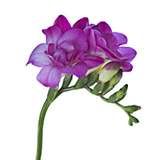
This is one of our favorite flowers to have around for the spring! Freesia is one of the most fragrant and widely grown flower in the world. Here are some facts and care tips about Freesia.
~ Freesia is native to South Africa, mainly found around the Cape province. It takes it's name from a German physician Friedrich Freese, he was a student of South African plants.
~ They are a member of the Iridaceae family. Most of the hybrids are close relatives to: Watsonia, Iris, Gladiolus, Crocus, and Ixia.
~ Today over 300 hybrids of Freesia are grown. The majority of those are greenhouse cultivated.
~ They are grown from corms - bulb like structures that look a lot like small onions.
~ The slender stems are home to six or seven trumpet shaped florets that bloom in a row on a "comb".
~ The single and double flowered cultivars are mostly seen in, white, cream, pink, red, orange, yellow, bronze, violet, lavender, mauve, and bicolor.
~ Freesia is available year around. The best supplies are from March to May and again from October to December.
~ The best time to purchase Freesia is when the first floret on each stem has started to open and at least a few others show color. More florets will open but it is very rare to see all of them open.
~ Avoid buying any that are brown or shriveled. This is the sign that they are on the way out of this world.
~ Place your Freesia arrangements in cool locations out of direct sunlight and away from air vents. Add warm preservative water daily or as needed to prolong vase life. Re-cut stems at an angle and under water every few days. Put Freesia in the coldest room of the house at night. Mist them daily with cool water for longer enjoyment.
This is our first "Facts & Care" segment and we hope you learned something new today. We are going to share our knowledge about fresh, potted, and silk plants with you. Please let us know what plants or flowers you would like to learn about. We love to hear from you. You can post here or go to our facebook page and leave us a message by clicking here.
For more fresh flower care visit our Care & Handling Blog.
No comments:
Post a Comment